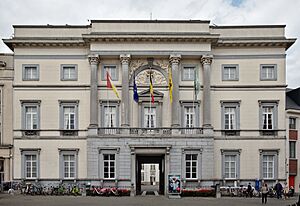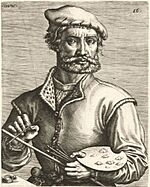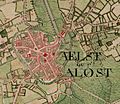Aalst, Belgium facts for kids
Quick facts for kids
Aalst
Oilsjt (Brabantian)
Alost (French)
|
|||
|---|---|---|---|

Montage of Aalst
|
|||
|
|||
| Country | Belgium | ||
| Community | Flemish Community | ||
| Region | Flemish Region | ||
| Province | East Flanders | ||
| Arrondissement | Aalst | ||
| Area | |||
| • Total | 78.12 km2 (30.16 sq mi) | ||
| Population
(2018-01-01)Lua error in Module:Wd at line 1575: attempt to index field 'wikibase' (a nil value).
|
|||
| • Total | Lua error in Module:Wd at line 1,575: attempt to index field 'wikibase' (a nil value). | ||
| Postal codes |
9300, 9308, 9310, 9320
|
||
| Area codes | 053 | ||
| Website | www.aalst.be | ||
Aalst (pronounced like "Ahlst") is a city and a group of towns in the East Flanders province of Belgium. It is located on the Dender River, about 30 kilometers (19 miles) northwest of Brussels. The city of Aalst includes smaller villages like Baardegem and Moorsel. It is the tenth largest city in Belgium by population, with over 90,000 people. The current mayor is Christoph D'Haese. Aalst has a long-standing friendly rivalry with the nearby town of Dendermonde, which started way back in the Middle Ages!
Contents
History of Aalst
Early Beginnings
The first records of Aalst are from the 800s. Back then, it was called villa Alost and was part of a big abbey. During the Middle Ages, Aalst became an important town and port. This was because it was a key spot where a road from Bruges to Cologne crossed the Dender River.
Aalst was once the capital of a part of Flanders within the Holy Roman Empire. In 1046, it became part of the County of Flanders. Its location on the border of the Holy Roman Empire helped the town stay somewhat independent. The city's white and red colors on its coat of arms show its connection to the old region of Lotharingia.
Golden Age and Challenges
Building the town hall started in the mid-1100s. This makes it the oldest town hall still standing in Belgium! Many old writings from this time are still kept in the city's archives.
In the 1300s, during the Hundred Years War, Aalst supported Louis de Male. The town hall and much of the city were destroyed by a big fire in 1360. But Aalst was quickly rebuilt. A new, tall bell tower (called a belfry) was added in the 1400s. This was a very successful time for the city, especially for its powerful weaving businesses.
During this period, a local person named Dirk Martens became the first printer in the Southern Netherlands. He opened his printing shop in 1473. He printed books by famous people, including Christopher Columbus. Martens later became a professor and is buried in the Saint Martin's Church.
Modern Times
Aalst faced many difficulties during the Eighty Years' War (1568–1648). It was later taken over by France in 1667 and stayed under French rule until 1706. After this, Aalst became independent again. The textile industry, which makes cloth, grew a lot when the French were in charge.
In 1830, Belgium became an independent country, and Aalst became part of it. This ended a long time of being controlled by other countries like Spain, Germany, France, and the Netherlands. The 1800s brought big changes with the Industrial Revolution. Father Adolf Daens became a local hero, fighting for workers' rights.
In the 1900s, Aalst was bombed and occupied by German forces during both World War I and World War II.
What Aalst Makes
The textile industry is still very important in Aalst. This means they make a lot of cloth, clothing, and shoes. They also build many of the machines needed for these industries.
The areas around Aalst are known for growing hops. Hops are used to make beer and are sold to local breweries. The region also has a large business growing and selling cut flowers.
Fun Carnival!
Aalst is famous for its lively carnival celebrations. These happen every year just before Lent. During the carnival, people gather at the old town hall belfry for a fun tradition: "throwing of the onions."
A "Prince Carnival" is chosen, and this person gets to "rule" the city for three days! On Sunday, a huge parade goes through the city. It has about 70 groups of people in costumes and decorated parade cars.
Carnival Tuesday is known as the day of the 'Voil Jeannetten'. This means "the Dirty Jennies," and it's when men dress up as women. The carnival fun ends on Tuesday evening with the "Burning of the Doll" ceremony.
Aalst on Screen
Aalst has been featured in several TV shows and movies:
- The Belgian TV police show, 13 Geboden (13 Commandments), was filmed in Aalst.
- The Belgian historical drama Thieves of the Wood takes place in and around Aalst.
- The 1992 movie Daens, about Adolf Daens, is set in Aalst. The director, Stijn Coninx, also filmed his 2018 movie Niet Schieten in Aalst.
Cool Places to See
- The 15th-century Belfry of Aalst is next to the town hall. It has a carillon with 52 bells, which is the oldest in Belgium. This belfry and the nearby Aldermen's House are recognized by UNESCO as a World Heritage Site.
- The famous "unfinished" St. Martin's Collegiate Church was built in the 1400s. It has a painting by the famous artist Peter Paul Rubens. It also has a special cabinet (called a tabernacle) from 1605 with sculptures by Hiëronymus Duquesnoy the Elder, who also created the famous Manneken Pis statue.
- You can see a statue of Dirk Martens (1450–1534), who was the first book printer in the Southern Netherlands.
- The old breweries in the area grow their own hops.
- The Town square has another statue of Martens, along with a statue of Charles V.
- The city has a lovely green space called the park.
- The 19th-century Saint-Joseph Church is built in the Neo-Gothic style.
- The 19th-century Onze-Lieve-Vrouw van Meuleschettekapel is another interesting chapel.
Famous People from Aalst
Many notable people come from Aalst, including:
- Jo Bogaert (born 1956), a Belgian DJ.
- Louis Paul Boon (1912–1979), a well-known writer and journalist.
- Franz Cumont (1868–1947), an expert in ancient history and languages.
- Adolf Daens (1839–1907), a priest and politician who fought for workers' rights.
- Remco Evenepoel (born 2000), a professional cyclist.
- Luc Luycx (born 1958), who designed the common side of the euro coins.
- Dirk Martens (around 1446–1534), the first book printer in the Southern Netherlands.
- Pieter Coecke van Aelst (1502–1550), a painter, sculptor, and architect.
- Peter Van Der Heyden (born 1976), a Belgian international football player.
- Dimitri Verhulst (born 1972), a writer and poet.
Getting Around
Aalst has several train stations:
- Aalst railway station
- Aalst Kerrebroek railway station
- Erembodegem railway station
City Symbols
The Flag
The flag of Aalst is a rectangle with three vertical stripes: red, white, and yellow. In the middle white stripe, there is a red sword pointing upwards.
The Coat of Arms
The coat of arms for Aalst was officially given in 1819. The oldest known seals of Aalst from the 1200s and 1300s show a knight with a sword and a flag. A very old seal from 1174 already showed the sword and flag.
The sword on the coat of arms likely comes from these old seals. The two smaller shields on the main shield show an Imperial eagle and a Flemish lion. These symbols remind us of Aalst's unique history and its connection to both the Holy Roman Empire and Flanders.
The coat of arms is a white shield with a gold crown on top. A red sword points upwards, dividing the shield. On the right side, there's a gold shield with a black double-headed eagle. On the left side, there's a gold shield with a black lion. Both the eagle and the lion have red tongues and claws.
Sports Teams
Aalst is home to several professional sports teams:
- The basketball club Okapi Aalstar.
- The football (soccer) club Eendracht Aalst, which plays in the second division.
- The volleyball club VK Aalst, started in the 1960s, plays in the first division.
- The MotoGP team Repsol Honda is based in Aalst.
Twin Cities
Aalst is twinned with these cities:
Images for kids
See also
 In Spanish: Aalst para niños
In Spanish: Aalst para niños













